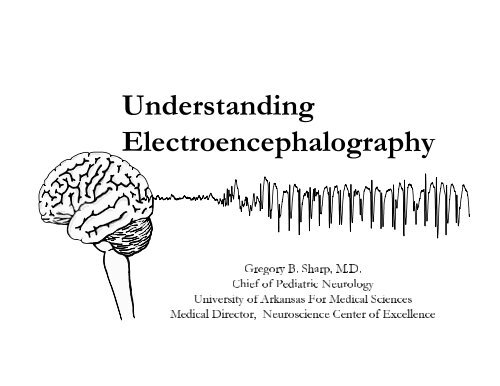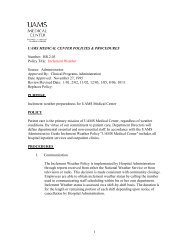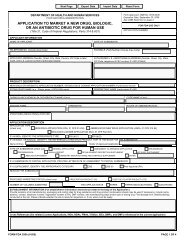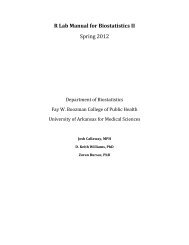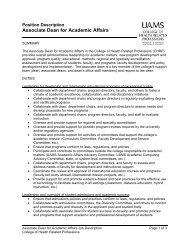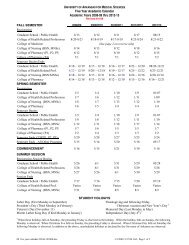Understanding Electroencephalography - University of Arkansas for ...
Understanding Electroencephalography - University of Arkansas for ...
Understanding Electroencephalography - University of Arkansas for ...
You also want an ePaper? Increase the reach of your titles
YUMPU automatically turns print PDFs into web optimized ePapers that Google loves.
B. Sharp, M.D.<br />
Gregory<br />
<strong>of</strong> Pediatric Neurology<br />
Chief<br />
<strong>of</strong> <strong>Arkansas</strong> For Medical Sciences<br />
<strong>University</strong><br />
Director, Neuroscience Center <strong>of</strong> Excellence<br />
Medical<br />
<strong>Understanding</strong><br />
<strong>Electroencephalography</strong>
The Source <strong>of</strong> EEG<br />
EEG = a measure <strong>of</strong> cerebral electrical activity<br />
The generator sources <strong>for</strong> EEG waves are within the<br />
cerebral cortex<br />
Electrical activity recorded on the scalp is produced<br />
by extracellular current flow associated with<br />
summated excitatory and inhibitory postsynaptic<br />
potentials (EPSPs(<br />
and IPSPs)<br />
Individual action potentials do not contribute<br />
directly to EEG activity
Synaptic Potentials:<br />
The Basis <strong>of</strong> EEG Activity<br />
Synaptic potentials are <strong>of</strong> much lower voltage<br />
than action potentials, but the produced current<br />
has a much larger distribution<br />
PSPs have a longer duration and involve a larger<br />
amount <strong>of</strong> membrane surface area than APs
EPSPs and IPSPs<br />
EPSP – produces a change in membrane<br />
permeability within a select portion <strong>of</strong> the cell<br />
membrane resulting in a net influx <strong>of</strong> + ions that<br />
depolarizes the cell<br />
IPSP – selective activation <strong>of</strong> either Cl or K channels resulting in a net outward ionic +<br />
- current<br />
with hyperpolarization <strong>of</strong> the cell
EEG: A Reflection <strong>of</strong> Current<br />
Spontaneous EEG activity occurs when currents<br />
flow across charged neuronal membranes<br />
An EEG wave<strong>for</strong>m reflects a summation <strong>of</strong><br />
PSPs from thousands or even millions <strong>of</strong><br />
cortical neurons<br />
The EEG represents the “average” behavior <strong>of</strong><br />
large neuronal aggregates<br />
The current flow from positive to negative is<br />
arranged in a dipole
The Dipole<br />
Theoretically, the current flows in a 3-3<br />
dimensional ellipse with the greatest current<br />
density along a straight line connecting the<br />
positive pole to the negative pole<br />
The complex arrangement <strong>of</strong> the brain and<br />
head, differences in cell type and function within<br />
a region, and physical differences between brain<br />
areas result in an approximate dipole that is not<br />
a perfect model.
Rhythmical vs. Arrhythmical<br />
EEG Activity<br />
When EEG waves are rhythmical, most <strong>of</strong> the<br />
cells within the given neuronal pool are<br />
behaving similarly<br />
With arrhythmic activity, there is less correlation<br />
with individual cell behavior
Pyamidal Cells:<br />
Principal Current Generators <strong>of</strong> EEG<br />
Topographical organization within the cortical<br />
mantle corresponds to a dipoles oriented<br />
perpendicular to the cortical surface
Factors Affecting EEG Wave<strong>for</strong>ms<br />
Voltage <strong>of</strong> the cortical discharge<br />
Area involved in synchronous activity<br />
Degree <strong>of</strong> synchrony<br />
Location <strong>of</strong> the dipole generators in relation to<br />
the convolutions <strong>of</strong> the cortical mantle.
Factors that Attenuate Voltage<br />
Primarily overlying spinal fluid and dura<br />
Scalp to a lesser extent<br />
Scalp recorded activity represents “spatial averaging” <strong>of</strong><br />
electrical activity from a limited area <strong>of</strong> cortex<br />
20-70% <strong>of</strong> epilepti<strong>for</strong>m activity may not be seen on<br />
scalp EEG<br />
Involvement <strong>of</strong> small areas <strong>of</strong> tissue is associated with much<br />
greater attenuation <strong>of</strong> activity<br />
Activity arising from cortex within the walls or depths <strong>of</strong> sulci<br />
may not be recorded
Origin <strong>of</strong> EEG Rhythmicity<br />
Rhythmical activity – sequences <strong>of</strong> regularly recurring<br />
wave<strong>for</strong>ms <strong>of</strong> similar shape and duration<br />
Rhythmical activity may be locally generated or occur<br />
via projected synaptic inputs from deeper structures<br />
The thalamus, via an anatomic cellular organization,<br />
thalamocortical projections and mechansims that are<br />
not fully understood, governs different types <strong>of</strong><br />
rhythmical activity<br />
Sleep spindles<br />
Alpha rhythm in the occipital cortex<br />
3 per second spike and wave associated with absence seizures
Vertex Wave and Sleep Spindles<br />
Fp1-F3<br />
F3-C3<br />
Fp1-F3<br />
C3-P3<br />
P3-O1<br />
F3-C3<br />
Fp2-F4<br />
C3-P3<br />
F4-C4<br />
C4-P4<br />
P3-O1<br />
P4-O2<br />
Fp2-F4<br />
Fp1-F7<br />
F7-T 3<br />
F4-C4<br />
T3-T5<br />
C4-P4<br />
T5-O1<br />
P4-O2<br />
Fp2-F8<br />
F8-T 4<br />
T4-T6<br />
T6-O2
Posterior Alpha Rhythm<br />
Fp1-F3<br />
F3-C3<br />
C3-P3<br />
P3-O1<br />
Fp2-F4<br />
F4-C4<br />
C4-P4<br />
P4-O2
Epilepti<strong>for</strong>m Discharges: Spikes<br />
Indicate susceptibility to seizures<br />
May be generalized or focal<br />
Focal spikes – cortical spikes are associated<br />
with synchronous paroxysmal depolarizing<br />
bursts occurring in neurons within the focus<br />
resulting in extracellular current flow that is<br />
recorded as surface spikes
The Spike and Wave Complex<br />
The cellular depolarizing bursts are followed by<br />
long-lasting<br />
lasting afterhyperpolarization in cells within<br />
the focus<br />
Additional inhibition occurs in surrounding<br />
cortex, thalamus and other subcortical areas<br />
This results in a surface slow wave that follows<br />
the individual spike
Left Temporal Spikes<br />
Fp1-F7<br />
F7-T3<br />
T3-T5<br />
Spike and slow wave complex
Neuronal Synchronization<br />
The interictal spike may be initiated by a<br />
spontaneous burst in one or a few cells<br />
Each cell has excitatory connections to a<br />
number <strong>of</strong> other cells<br />
Excitatory connections will allow burst<br />
propagation if inhibition is decreased, absent or<br />
simply overcome<br />
Loss <strong>of</strong> effective dendritic inhibitory synapses<br />
may occur over time
Generalized Spike-and<br />
and-Wave<br />
A pathological exaggeration <strong>of</strong> cortical excitability is the<br />
basic disturbance and appears to initiate the process<br />
Cortical spikes precede epilepti<strong>for</strong>m discharges in<br />
depths<br />
Thalamocortical connections are necessary <strong>for</strong><br />
triggering and phasing the spike-and<br />
and-wave bursts<br />
The brainstem reticular <strong>for</strong>mation appears to modulate<br />
spike-and<br />
and-wave activity by modifying the level <strong>of</strong><br />
cortical excitability.<br />
Substantia nigra involvement in some way is essential in<br />
the production <strong>of</strong> generalized convulsions.
EEG Frequencies<br />
Delta<br />
Theta<br />
Alpha 8 - 13<br />
Beta<br />
0 - 4 Hertz<br />
4 - 7 Hertz<br />
13 Hetrz<br />
> 13 Hertz
EEG in Neonates<br />
Premature newborn – due to the incomplete<br />
development <strong>of</strong> neuronal connections, synapse<br />
<strong>for</strong>mation, myelination, , etc., EEG activity prior<br />
to 30 weeks estimated gestational age (EGA) is<br />
disccontinuous and very “abnormal” appearing<br />
Focal sharp discharges in frontal and temporal<br />
regions are normal to some extent until about<br />
44 weeks EGA
Trace Discontinue in 27 week EGA Neonate<br />
Fp1-F7<br />
F7-T5<br />
T5-O1<br />
Fp1-F3<br />
F3-P3<br />
P3-O1<br />
Fp2-F4<br />
F4-P4<br />
P4-O2<br />
Fp2-F8<br />
F8-T6<br />
T6-O2
2 month old with Enterococcal meningitis and left posterior<br />
temporal focal electrographic seizure<br />
FP1-F7<br />
F7-T5<br />
T5-O1<br />
FP1-F3<br />
F3-P3<br />
P3-O1<br />
Fp2-F4<br />
F4-P4<br />
P4-O2<br />
Fp2-F8<br />
F8-T6<br />
T6-O2<br />
1 sec<br />
50 µV
2 month old with Enterococcal meningitis with an<br />
electrographic seizure discharge, maximal right frontal<br />
FP1-F7<br />
F7-T5<br />
T5-O1<br />
FP1-F3<br />
F3-P3<br />
P3-O1<br />
Fp2-F4<br />
F4-P4<br />
P4-O2<br />
Fp2-F8<br />
F8-T6<br />
T6-O2<br />
1 sec<br />
50 µV
2 month old with Enterococcal meningitis and right posterior<br />
temporal focal electrographic seizure<br />
FP1-F7<br />
F7-T5<br />
T5-O1<br />
FP1-F3<br />
F3-P3<br />
P3-O1<br />
Fp2-F4<br />
F4-P4<br />
P4-O2<br />
Fp2-F8<br />
F8-T6<br />
T6-O2<br />
1 sec<br />
50 µV
2 month old with Enterococcal meningitis and bilateral<br />
independent focal electrographic seizures<br />
FP1-F7<br />
F7-T5<br />
T5-O1<br />
FP1-F3<br />
F3-P3<br />
P3-O1<br />
Fp2-F4<br />
F4-P4<br />
P4-O2<br />
Fp2-F8<br />
F8-T6<br />
T6-O2<br />
1 sec<br />
50 µV
Progression <strong>of</strong> EEG in Childhood<br />
Occipital rhythmical activity = Alpha rhythm<br />
3-55 months 3.5-4.5 Hertz<br />
12 months 5-66 Hertz<br />
3 years 7.5-9.5 Hertz<br />
9 years >9 Hertz
EEG During Sleep<br />
Stage I sleep<br />
Dropout <strong>of</strong> alpha rhythm<br />
Intermixed slowing<br />
Stage II sleep<br />
Increased intermixed theta and delta slowing<br />
Vertex waves, sleep spindles and K-complexesK<br />
Positive occipital sharp transients <strong>of</strong> sleep (POSTs(<br />
POSTs)
Progression <strong>of</strong> Sleep<br />
Stage III sleep<br />
Increased delta slowing<br />
Central vertex activity diminishes<br />
Stage IV sleep<br />
Marked delta slowing<br />
Absence <strong>of</strong> vertex activity<br />
Stage III and IV = Slow wave sleep
Stage 3-43<br />
4 Sleep<br />
Fp1-F3<br />
F3-C3<br />
C3-P3<br />
P3-O1<br />
Fp2-F4<br />
F4-C4<br />
C4-P4<br />
P4-O2<br />
Fp1-F7<br />
F7-T3<br />
T3-T5<br />
T5-O1<br />
Fp2-F8<br />
F8-T4<br />
T4-T6<br />
T6-O2
REM Sleep<br />
Low voltage mixed frequency activity with faster<br />
components<br />
Absent vertex activity<br />
Decreased EMG activity
Focal Epilepti<strong>for</strong>m Discharges<br />
and Abnormalities<br />
Spikes and sharp waves<br />
Phase reversal localizes the focus<br />
Recorded seizures<br />
Focal slowing may indicate an underlying<br />
epileptogenic focus, structural lesion or injury,<br />
or postictal effect
Localization: Phase Reversal<br />
Each channel records the<br />
potential difference between<br />
two electrodes<br />
G1 – G2<br />
Negative is up<br />
If G1 is more negative than<br />
G2, the deflection will be up<br />
If G2 is more negative, the<br />
deflection will be down<br />
FP1-F7<br />
F7-T3<br />
T3-T5<br />
FP1-F7
Generalized EEG Abnormalities<br />
Generalized spike and wave<br />
Generalized polyspike-wave or multispike-wave<br />
Generalized slow spike and wave<br />
Generalized 3 Hertz spike-wave<br />
Generalized slowing<br />
Generalized suppression<br />
Generalized burst suppression<br />
Electrocerebral silence
Generalized Spike-Wave<br />
Fp1-F3<br />
F3-C3<br />
C3-P3<br />
P3-O1<br />
Fp2-F4<br />
F4-C4<br />
C4-P4<br />
P4-O2<br />
Fp1-F7<br />
F7-T3<br />
T3-T5<br />
T5-O1<br />
Fp2-F8<br />
F8-T4<br />
T4-T6<br />
T6-O2
Generalized Polyspike Wave<br />
Fp1-F3<br />
F3-C3<br />
C3-P3<br />
P3-O1<br />
Fp2-F4<br />
F4-C4<br />
C4-P4<br />
P4-O2<br />
Fp1-F7<br />
F7-T3<br />
T3-T5<br />
T5-O1<br />
Fp2-F8<br />
F8-T4<br />
T4-T6<br />
T6-O2
3 Hertz Spike and Wave<br />
Fp1-F3<br />
F3-C3<br />
C3-P3<br />
P3-O1<br />
Fp2-F4<br />
F4-C4<br />
C4-P4<br />
P4-O2<br />
1 sec<br />
50 µV
Generalized Delta Slowing<br />
Fp1-F3<br />
F3-C3<br />
C3-P3<br />
P3-O1<br />
Fp2-F4<br />
F4-C4<br />
C4-P4<br />
P4-O2<br />
Fp1-F7<br />
F7-T3<br />
T3-T5<br />
T5-O1<br />
Fp2-F8<br />
F8-T4<br />
T4-T6<br />
T6-O2
EEG in the Evaluation <strong>of</strong><br />
Possible Epilepsy<br />
For patients with epilepsy, a single EEG will<br />
reveal epilepti<strong>for</strong>m activity in:<br />
30-40% with an awake EEG only<br />
60-70% with wakefulness and sleep<br />
Some patients will only have an abnormality<br />
detected if an actual seizure is recorded<br />
A normal EEG does not rule out a diagnosis <strong>of</strong><br />
epilepsy
EEG Monitoring in Critical Care<br />
Many patients with head injury, any <strong>for</strong>m <strong>of</strong><br />
encephalopathy, or severe illness are at risk <strong>for</strong> seizures<br />
Patients who are mechanically ventilated are <strong>of</strong>ten<br />
sedated and pharmacologically paralyzed and seizures<br />
can only be diagnosed with EEG<br />
The diagnosis <strong>of</strong> nonconvulsive status epilepticus can<br />
only be detected and monitored with EEG<br />
Monitoring progression <strong>of</strong> coma and potentially<br />
cerebral death
11 y/o boy with severe cardiomyopathy on ECMO following<br />
cardiac electromechanical disassociation<br />
Fp1-F7<br />
F7-T3<br />
T3-T5<br />
T5-O1<br />
Fp2-F8<br />
F8-T4<br />
T4-T6<br />
T6-O2<br />
Fp1-F3<br />
F3-C3<br />
C3-P3<br />
P3-O1<br />
Fp2-F4<br />
F4-C4<br />
C4-P4<br />
P4-O2<br />
1 sec<br />
50 µV
11 y/o boy with severe cardiomyopathy on ECMO with right temporal<br />
electrographic seizure<br />
Fp1-F7<br />
F7-T3<br />
T3-T5<br />
T5-O1<br />
Fp2-F8<br />
F8-T4<br />
T4-T6<br />
T6-O2<br />
Fp1-F3<br />
F3-C3<br />
C3-P3<br />
P3-O1<br />
Fp2-F4<br />
F4-C4<br />
C4-P4<br />
P4-O2<br />
1 sec<br />
50 µV
Focal Status Epilepticus<br />
Fp1-F7<br />
F7-T3<br />
T3-T5<br />
T5-O1<br />
Fp2-F8<br />
F8-T4<br />
T4-T6<br />
T6-O2<br />
Fp1-F3<br />
F3-C3<br />
C3-P3<br />
P3-O1<br />
Fp2-F4<br />
F4-C4<br />
C4-P4<br />
P4-O2<br />
1 sec<br />
50 µV
11 y/o boy with severe cardiomyopathy on ECMO with left<br />
hemispheric suppression due to infarction<br />
Fp1-F7<br />
F7-T3<br />
T3-T5<br />
T5-O1<br />
Fp2-F8<br />
F8-T4<br />
T4-T6<br />
T6-O2<br />
Fp1-F3<br />
F3-C3<br />
C3-P3<br />
P3-O1<br />
Fp2-F4<br />
F4-C4<br />
C4-P4<br />
P4-O2<br />
1 sec<br />
50 µV
EEG Monitoring and<br />
Epilepsy Surgery<br />
20% <strong>of</strong> patients with epilepsy cannot be<br />
controlled with medications<br />
Focal onset seizures can sometimes be selected<br />
and treated with surgical resection <strong>of</strong> the<br />
epileptogenic focus<br />
Multiple methods are can be employed
Clinical Case<br />
8.5 year old boy with onset <strong>of</strong> seizures at age 7<br />
Seizures begin with a tingling sensation in the R hand<br />
followed by extension and posturing <strong>of</strong> the R arm<br />
Seizures were never completely controlled with about 1<br />
seizure per week <strong>for</strong> the first year<br />
December, 2001: Seizures began to dramatically<br />
increase<br />
January-March, 2002: Numerous seizures per day with<br />
up to 100 in a single day, and episodes <strong>of</strong> status<br />
epilepticus lasting up to 1 hour
Typical Seizure
EEG: Recorded Seizure<br />
*Fp1-F3<br />
*F3-C3<br />
*C3-P3<br />
*P3-O1<br />
Fp2-F4<br />
F4-C4<br />
C4-P4<br />
*P4-O2<br />
1 sec<br />
50 µV
*Fp1-F3<br />
*F3-C3<br />
*C3-P3<br />
*P3-O1<br />
Fp2-F4<br />
F4-C4<br />
1 sec<br />
50 µV<br />
C4-P4<br />
*P4-O2
*Fp1-F3<br />
*F3-C3<br />
*C3-P3<br />
*P3-O1<br />
Fp2-F4<br />
F4-C4<br />
1 sec<br />
50 µV<br />
C4-P4<br />
*P4-O2
MRI Findings
3D-MRI Image
3D-MRI with Coronal Cut
Craniotomy with Lesion Localization
Grid Placement
Cortical Grid Map
Craniotomy Closure
Electrocortical Seizure Recording<br />
41-42<br />
42-43<br />
43-44<br />
44-45<br />
45-46<br />
49-50<br />
50-51<br />
51-52<br />
52-53<br />
53-54<br />
1 sec<br />
50 µV<br />
54-55
41-42<br />
42-43<br />
43-44<br />
44-45<br />
45-46<br />
49-50<br />
50-51<br />
51-52<br />
52-53<br />
53-54<br />
1 sec<br />
50 µV<br />
54-55
41-42<br />
42-43<br />
43-44<br />
44-45<br />
45-46<br />
49-50<br />
50-51<br />
51-52<br />
52-53<br />
53-54<br />
1 sec<br />
50 µV<br />
54-55
Functional Cortical Mapping
Cortical Stimulation: Arm
Functional Cortical Map
Cortical Resection
Second Surgery: Stereotactic Lesion Localization
Depth EEG Recording<br />
33-34<br />
34-35<br />
35-36<br />
100 uV<br />
1 sec
Outcome
2 month old with Enterococcal meningitis with an<br />
electrographic seizure discharge, maximal right frontal<br />
FP1-F7<br />
F7-T5<br />
T5-O1<br />
FP1-F3<br />
F3-P3<br />
P3-O1<br />
Fp2-F4<br />
F4-P4<br />
P4-O2<br />
Fp2-F8<br />
F8-T6<br />
T6-O2<br />
1 sec<br />
50 µV


